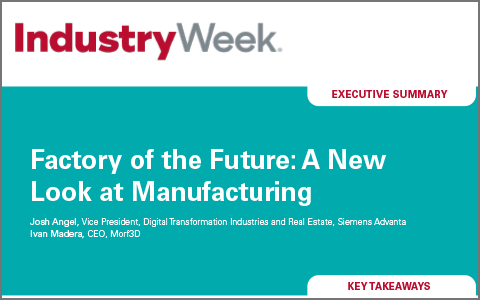EXECUTIVE SUMMARY
Factory of the Future: A New Look at Manufacturing
Factory of the Future: A New Look at Manufacturing
With today’s labor shortages and supply chain issues, many manufacturers are accelerating the adoption of emerging technologies to reach their business goals. Additive manufacturing (AM) has become an important digital, ecological, and increasingly cost-competitive alternative to traditional production technologies. To deploy a scalable, sustainable, and future-proof AM capability, leading manufacturers are partnering with experts like Siemens Advanta to provide best-in-breed expertise.
Panelists
Context
Panelists
Context
Factory of the Future: A New Look at Manufacturing
Key Takeaways
Additive manufacturing delivers ROI in several ways:
Opportunities exist to reduce costs and improve process productivity by up to 80%.
Opportunities exist to reduce costs and improve process productivity by up to 80%.
Process steps can be reduced by upward of 80%, leading to shorter development time and faster time to market.
Process steps can be reduced by upward of 80%, leading to shorter development time and faster time to market.
Many companies experience a 50% reduction in lead times due to optimized material and information flows.
Many companies experience a 50% reduction in lead times due to optimized material and information flows.
Manufacturers can reduce greenhouse gas emissions by up to 30% by eliminating transport and reducing product weight.
Manufacturers can reduce greenhouse gas emissions by up to 30% by eliminating transport and reducing product weight.
Morf3D has partnered with Siemens Advanta to construct a future-proof factory.
– Josh Angel, Siemens Advanta
– Josh Angel, Siemens Advanta
To increase manufacturing flexibility, Morf3D is certifying and qualifying its production system rather than parts.
Customers
Production System
Digital Twin

Customers
Production System
Digital Twin

Customers
Production System
Digital Twin

– Ivan Madera, Morf3D
– Ivan Madera, Morf3D
When deploying an additive manufacturing strategy, digital twins can play a central role.
Digital twins can be used to identify the most promising candidates for AM and to maximize their impact to the business. It is possible to simulate changes with the digital twin and then implement processes for manufacturability. The factory piece is where companies leverage digital twins to exploit the full potential of the digitalization plan. The digital twin can be used in conjunction with performance KPIs, like reducing lead times, design costs, and planning costs.
For Morf3D’s digital twins, Siemens Advanta worked closely with the team to collaboratively plan and design the digital layout in the software and then simulate material flows and actual processes. The closed-loop nature of digital twins is very important since continuous feedback is critical to success.
Every manufacturer is unique, so the journey to AM requires a personalized approach. With its advanced manufacturing network and extensive expertise, Siemens Advanta creates unique solutions for different clients that meet each organization’s specific needs and utilize best-of-breed capabilities from the network. By focusing heavily on change management, Siemens Advanta helps customers create quick wins, prove the value of AM, and ensure success. A holistic approach to AM including change management is critical to realizing the full potential of these technologies for companies like Morf3D.
– Daniel Scharfen, Infineon Technologies
Looking ahead, partnerships and ecosystems will be crucial for scaling additive manufacturing.
With everyone at the table, it will be possible to transform the industry.
Additional Resources
Webinar Executive Summary


Read this use case to learn how Siemens and Morf3D partnered up to design a new site for 3D printing.

Siemens and BMW Group teamed up to develop a Digital Twin based on a 3D material flow simulation model. Read this asset to learn more.



